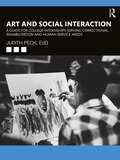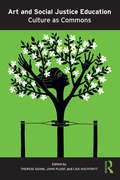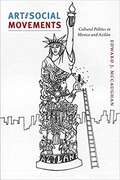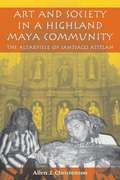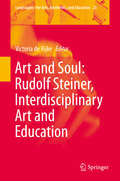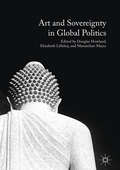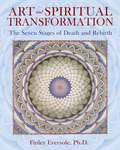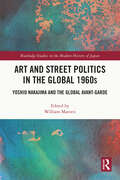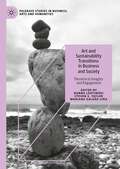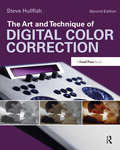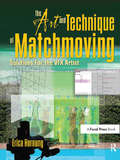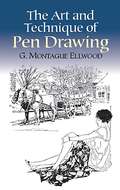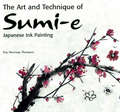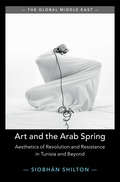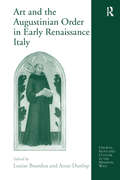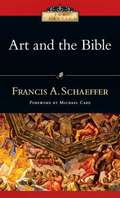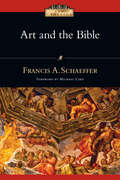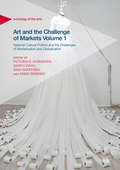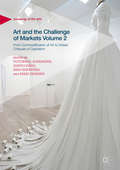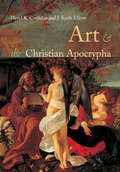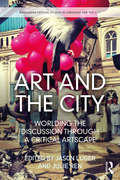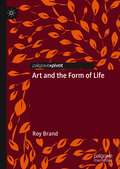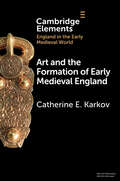- Table View
- List View
Art and Social Interaction: A Guide for College Internships Serving Correctional, Rehabilitation and Human Service Needs
by Judith PeckThis manual contains the information needed for human service institutions, liberal arts colleges, and community volunteers to present a program of creative visual arts in jails, psychiatric facilities, drug rehabilitation centres, nursing homes, shelters and facilities for youth in need. By engaging in one-on-one artistic interaction with the individuals served, students not only perform community service but gain unique personal understanding of the major domestic issues of our time—crime, mental illness, substance abuse, domestic abuse and aging. The covered activities are designed to stimulate memory, acknowledge experience and achievement, and improve self-esteem. Delivering everything needed to set up the course in any liberal arts college, the book offers approaches for diverse populations and covers planning and execution, aesthetic and humanistic objectives, projected outcomes, and methods of evaluation. Techniques are presented for drawing, painting, collage, sculpture and crafts. By adopting this manual, colleges with programs in art and social work, can provide students with education relevant to their lives and potential careers while providing a unique service to social service institutions.
Art and Social Justice Education: Culture as Commons
by Therese Quinn, John Ploof, and Lisa HochtrittArt and Social Justice Education offers inspiration and tools for educators to craft critical, meaningful, and transformative arts education curriculum and arts integration projects. The images, descriptive texts, essays, and resources are grounded within a clear social justice framework and linked to ideas about culture as commons. Essays and a section written by and for teachers who have already incorporated contemporary artists and ideas into their curriculums help readers to imagine ways to use the content in their own settings. This book is enhanced by a Companion Website (www.routledge.com/cw/quinn) featuring artists and artworks, project examples, and dialogue threads for educators. Proposing that art can contribute in a wide range of ways to the work of envisioning and making a more just world, this imaginative, practical, and engaging sourcebook of contemporary artists’ works and education resources advances the field of arts education, locally, nationally, and internationally, by moving beyond models of discipline-based or expressive art education. It will be welcomed by all educators seeking to include the arts and social justice in their curricula.
Art and Social Movements: Cultural Politics in Mexico and Aztlán
by Edward J. McCaughanArt and Social Movements offers a comparative, cross-border analysis of the role of visual artists in three social movements from the late 1960s through the early 1990s: the 1968 student movement and related activist art collectives in Mexico City, a Zapotec indigenous struggle in Oaxaca, and the Chicano movement in California. Based on extensive archival research and interviews, Edward J. McCaughan explores how artists helped to shape the identities and visions of a generation of Mexican and Chicano activists by creating new visual discourses. <p><p> McCaughan argues that the social power of activist artists emanates from their ability to provoke people to see, think, and act in innovative ways. Artists, he claims, help to create visual languages and spaces through which activists can imagine and perform new collective identities and forms of meaningful citizenship. The artists' work that he discusses remains vital today—in movements demanding fuller democratic rights and social justice for working people, women, ethnic communities, immigrants, and sexual minorities throughout Mexico and the United States. Integrating insights from scholarship on the cultural politics of representation with structural analyses of specific historical contexts, McCaughan expands our understanding of social movements.
Art and Society in a Highland Maya Community
by Allen J. Christenson"Allen J. Christenson offers us in this wonderful book a testimony to contemporary Maya artistic creativity in the shadow of civil war, natural disaster, and rampant modernization. Trained in art history and thoroughly acquainted with the historical and modern ethnography of the Maya area, Christenson chronicles in this beautifully illustrated work the reconstruction of the central altarpiece of the Maya Church of Tz'utujil-speaking Santiago Atitlán, Guatemala. The much-loved colonial-era shrine collapsed after a series of destructive earthquakes in the twentieth century. Christenson's close friendship with the Chávez brothers, the native Maya artists who reconstructed the shrine in close consultation with village elders, enables him to provide detailed exegesis of how this complex work of art translates into material form the theology and cosmology of the traditional Tz'utujil Maya. With the author's guidance, we are taught to see this remarkable work of art as the Maya Christian cosmogram that it is. Although it has the triptych form of a conventional Catholic altarpiece, its iconography reveals a profoundly Maya narrative, replete with sacred mountains and life-giving caves, with the whole articulated by a central axis mundi motif in the form of a sacred tree or maize plant (ambiguity intended) that is reminiscent of well-known ancient Maya ideas. Through Christenson's focused analysis of the iconography of this shrine, we are able to see and understand almost firsthand how the modern Maya people of Santiago Atitlán have remembered the imagined universe of their ancestors and placed upon this sacred framework their received truths in time present. "--Gary H. Gossen, Distinguished Professor Emeritus of Anthropology and Latin American Studies, University at Albany, SUNY
Art and Soul: Rudolf Steiner, Interdisciplinary Art and Education (Landscapes: the Arts, Aesthetics, and Education #25)
by Victoria De RijkeThis book brings together Steiner's philosophical, biodynamic and cultural contributions to education, where 'spirit' and ‘soul’ are the creative elements in human evolution. His thought is applied to selected examples of innovative artistic practice and pedagogy of the present. This volume is intended for researchers in the arts and education with an interest in Rudolf Steiner's huge influence on educational thought and policy.This is an urgent point in time to reflect on the role of arts in education and what it might mean for our souls. An accessible yet scholarly study of interdisciplinarity, imagination and creativity is of critical widespread interest now, when arts education in many countries is threatened with near-extinction.
Art and Sovereignty in Global Politics
by Maximilian Mayer Douglas Howland Elizabeth LillehojThis volume aims to question, challenge, supplement, and revise current understandings of the relationship between aesthetic and political operations. The authors transcend disciplinary boundaries and nurture a wide-ranging sensibility about art and sovereignty, two highly complex and interwoven dimensions of human experience that have rarely been explored by scholars in one conceptual space. Several chapters consider the intertwining of modern philosophical currents and modernist artistic forms, in particular those revealing formal abstraction, stylistic experimentation, self-conscious expression, and resistance to traditional definitions of "Art. " Other chapters deal with currents that emerged as facets of art became increasingly commercialized, merging with industrial design and popular entertainment industries. Some contributors address Post-Modernist art and theory, highlighting power relations and providing sceptical, critical commentary on repercussions of colonialism and notions of universal truths rooted in Western ideals. By interfering with established dichotomies and unsettling stable debates related to art and sovereignty, all contributors frame new perspectives on the co-constitution of artworks and practices of sovereignty.
Art and Spiritual Transformation: The Seven Stages of Death and Rebirth
by Finley EversoleThe primal role of art in awakening and liberating the soul of humanity • Presents a seven-stage journey of transformation moving from the darkened soul to the light of spiritual illumination • Provides a meditation practice to experience the spiritual energy embedded within art • Includes artists Alex Grey, Jackson Pollock, Mark Rothko, Walter Gaudnek, and others Art and Spiritual Transformation presents a seven-stage journey from the darkened soul to the light of spiritual illumination that is possible through the world of art. Finley Eversole introduces a meditation practice that moves beyond the visual content of an art form in order to connect with its embedded spiritual energy, allowing the viewer to tap in to the deeper consciousness inherent in the artwork and awaken dormant powers in the depths of the viewer’s soul. Examining modern and postmodern artwork from 1945 onward, Eversole reveals the influences of ancient Egypt, India, China, and alchemy on this art. He draws extensively on philosophy, myth and symbolism, literature, and metaphysics to explain the seven stages of spiritual death and rebirth of the soul possible through art: the experience of self-loss, the journey into the underworld, the experience of the dark night of the soul, the conflict with and triumph over evil, the awakening of new life in the depths of being, and the return and reintegration of consciousness on a higher plane of being, resulting finally in ecstasy, transfiguration, illumination, and liberation. To illustrate these stages, Eversole includes works by abstract expressionists Jackson Pollock, Willem de Kooning, and Mark Rothko and modern visionary artists Alex Grey and Ernst Fuchs, among others, to reveal the powerful and liberating forces art contributes to the transformation and evolution of human consciousness.
Art and Street Politics in the Global 1960s: Yoshio Nakajima and the Global Avant-Garde (Routledge Studies in the Modern History of Japan)
by William MarottiAnarchic street performances in late-1950s Japan; inauguration of the first Happenings in Antwerp and charging of the "magic circle" in Amsterdam; Bauhaus Situationiste and anti-national art exchanges, networks and communes. As "Happener" and "Art Missionary," Yoshio Nakajima’s storied career traverses an astounding range of locations, scenes, movements, media, and performance modes in the global 1960s and 1970s in ways that challenge our notions of the possibilities of art. Nakajima repeatedly plays a role in jump-starting spaces of possibility, from Tokyo to Ubbeboda, from Spui Square and the Dutch Provos to Antwerp and Sweden. Despite this, Nakajima’s work has paradoxically been largely excluded from accounts where it might have justifiably featured. The present volume represents an international collaboration of researchers working to remedy this oversight. Nakajima’s work demands a reconceptualization of narratives of this art and politics and their specific interrelation to consider his exemplary nonconformity—and its exemplary exclusion. This history demonstrates the inadequacy of notions of specificity that would oppose an authentic local or national frame to an inauthentic transnational one. Conversely, Nakajima manifests a key dimension of the 1960s as a global event in the interrelation between eventfulness itself and the redrawing of categories of practice and understanding.
Art and Sustainability Transitions in Business and Society: Theoretical Insights and Engagement (Palgrave Studies in Business, Arts and Humanities)
by Hanna Lehtimäki Steven S. Taylor Mariana Galvão LyraAn increased understanding of art and art-based-methods is needed to address the behavioral and cultural change in the sustainability transition. This edited collection explores ways to engage people in their citizen, consumer, employer, employee and entrepreneurial roles, as they grapple with the sustainability transition. It introduces art and arts-based methods to advance sustainability thinking. As a unique contribution to sustainability research, this book presents insights from artists, art organizations and specialists using arts-based-methods in education, organizational innovation and citizen engagement. The book will provide inspiring insights to scholars and students of sustainability, innovation, corporate strategy, and creativity in business.
The Art and Technique of Digital Color Correction
by Steve HullfishThe only guide to the art and technique of color correction based on the invaluable knowledge of more than a dozen of the top colorists in the world. This book allows you unprecedented access to the way the masters of the craft approach their work.Containing decades of industry experience and professional colorist know-how, this book provides an understanding of what top-tier colorists look for in an image and how they know what to do to make it great. Featuring techniques performed in a variety of color correction software applications (DaVinci Resolve, Apple Color, Synthetic Aperture's Color Finesse, and more), this book turns what has long been a misunderstood "black art" into a set of skills that any colorist, editor, independent filmmaker, or motion graphics artist can begin to master. Packed with explanations, tips, and concepts that build on each other, you will learn how to:* fix poorly exposed shots and shots with color casts* create looks* match shots* master primary and secondary color correction techniques* use color correction to advance a storyThis edition includes* Downloadable resources containing two hours of video tutorials using DaVinci Resolve, extended interview transcripts and color correction sessions with the professional colorists featured in the book * A brand new tutorial-based chapter, with companion project files on the downloadable resources, so you can work along with the text* New insight from additional professional colorists, including legendary colorists, Bob Festa, Stefan Sonnenfeld, and Pankaj Baipai, showing you the 'hows' and 'whys' of each grade
The Art and Technique of Matchmoving: Solutions for the VFX Artist
by Erica HornungMatchmoving has become a standard visual effects procedure for almost every situation where live action materials and CG get combined. It allows virtual and real scenes that have been composited together to seamlessly appear as though they are from the same perspective. This authoritative step-by-step guide from one of the best matchmovers in the business allows you to master this technique that has been called the foundation upon which all VFX work stands. Author Erica Hornung (sr. matchmover for Lord of the Rings: The Two Towers, Matrix: Revolutions, and more) imparts her techniques, tips, and wisdom from the trenches that will have you matchmoving like a true professional in no time. Lessons in the most popular matchmoving software (Maya, Boujou, and others) are included, as well as tips and techniques for surveying on set, dolly moves, and operating nodal cameras. Individual chapters dedicated to object and character matchmoves show you how to matchmove for shadow casting, adding weapons and other objects, focusing on center of gravity, as well as complete CG character support.The downloadable resources include Quicktime examples of techniques shown in the book, as well as project files that allow you to master these techniques yourself by working alongside the lessons featured in the text.
The Art and Technique of Pen Drawing
by G. Montague EllwoodA practical course in pen and ink drawing, this helpful guide includes a comprehensive survey of the best pen work in existence. A wide diversity of styles are presented - from loose sketches to rich, engraving-like studies. Works from all periods include drawings by such masters as Dürer, Holbein, Doré, Gibson, Rackham, Pyle, Beardsley, and Klinger. An opening chapter presents the evolution of pen drawing, while subsequent sections allow readers to select topics in self-contained units on line technique; the use of materials, drawing the figure, face and hands; humorous illustration; pen drawing for advertisers; fashion drawing; and landscape and architectural illustration. An excellent reference for students, this book will also help illustrators and commercial artists further develop their own styles.
The Art and Technique of Sumi-e Japanese Ink Painting
by Kay Morrissey ThompsonThe art of sumi-e, which literally means "ink picture," combines calligraphy and ink-painting to produce compositions of rare beauty. This beauty is paradoxical-ancient but modern, simple but complex, bold but subdued-no doubt reflecting the arts spiritual basis in Zen Buddhism. At the same time sumi-e is firmly rooted in the natural world, its various techniques serving as the painter's language for describing the wonders of nature.Art and Technique of Sumi-e Japanese Ink-Painting explores this ancient technique. Buddhist priests brought the ink stick and the bamboo-handled brush to Japan from China in the sixth century, and over the past fourteen centuries Japan has developed a rich heritage of ink-painting. Today the artistry of sumi-e can be admired in books, reproductions and museums, but the techniques of the art have been much less accessible. As a result, little information has been available to the inquisitive Western artist attracted to ink-painting. This book, designed to help remedy that deficiency, is the product of the author's study with her teacher, Ukai Uchiyama, master calligraphist and artist.
The Art and Technique of Sumi-e Japanese Ink Painting
by Kay Morrissey ThompsonThe art of sumi-e, which literally means "ink picture," combines calligraphy and ink-painting to produce compositions of rare beauty. This beauty is paradoxical-ancient but modern, simple but complex, bold but subdued-no doubt reflecting the arts spiritual basis in Zen Buddhism. At the same time sumi-e is firmly rooted in the natural world, its various techniques serving as the painter's language for describing the wonders of nature.Art and Technique of Sumi-e Japanese Ink-Painting explores this ancient technique. Buddhist priests brought the ink stick and the bamboo-handled brush to Japan from China in the sixth century, and over the past fourteen centuries Japan has developed a rich heritage of ink-painting. Today the artistry of sumi-e can be admired in books, reproductions and museums, but the techniques of the art have been much less accessible. As a result, little information has been available to the inquisitive Western artist attracted to ink-painting. This book, designed to help remedy that deficiency, is the product of the author's study with her teacher, Ukai Uchiyama, master calligraphist and artist.
Art and the Arab Spring: Aesthetics of Revolution and Resistance in Tunisia and Beyond (The Global Middle East #16)
by Siobhan ShiltonThe revolutions that began to sweep across countries in North Africa and the Middle East in December 2010 – like other revolutions in diverse modern historical contexts – have often been articulated, internally and externally, in black and white terms of success or failure, liberation or constraint, for or against, friend or enemy. These internal and external clichés are perpetuated by what Jellel Gasteli has called 'icons of revolutionary exoticism'. Paying particular attention to works from the Tunisian Revolution of 2011, this book examines a diverse body of art including photography, sculpture, graffiti, performance, video and installation by over twenty-five artists. Examining how art can evoke the idea of revolution, Art and the Arab Spring reveals a new way of understanding these revolutions, their profound cultural impact, and of the meaning of the term 'revolution' itself.
Art and the Augustinian Order in Early Renaissance Italy (Church, Faith and Culture in the Medieval West)
by Anne DunlopThe rise of the mendicant orders in the later Middle Ages coincided with rapid and dramatic shifts in the visual arts. The mendicants were prolific patrons, relying on artworks to instruct and impress their diverse lay congregations. Churches and chapels were built, and new images and iconographies developed to propagate mendicant cults. But how should the two phenomena be related? How much were these orders actively responsible for artistic change, and how much did they simply benefit from it? To explore these questions, Art and the Augustinian Order in Early Renaissance Italy looks at art in the formative period of the Augustinian Hermits, an order with a particularly difficult relation to art. As a first detailed study of visual culture in the Augustinian order, this book will be a basic resource, making available previously inaccessible material, discussing both well-known and more neglected artworks, and engaging with fundamental methodological questions for pre-modern art and church history, from the creation of religious iconographies to the role of gender in art.
Art and the Bible
by Francis A. SchaefferMany Christians, wary of creating graven images, have steered clear of artistic creativity. But the Bible offers a robust affirmation of the arts. The human impulse to create reflects our being created in the image of a creator God. Art and the Bible has been a foundational work for generations of Christians in the arts. In this book's classic essays, Francis Schaeffer first examines the scriptural record of the use of various art forms, and then establishes a Christian perspective on art. With clarity and vigor, Schaeffer explains why "the Christian is the one whose imagination should fly beyond the stars."
Art and the Bible: Two Essays (IVP Classics)
by Francis A. Schaeffer"The lordship of Christ should include an interest in the arts," writes Francis Schaeffer. "A Christian should use these arts to the glory of God, not just as tracts, mind you, but as things of beauty to the praise of God." Many Christians, wary of creating graven images, have steered clear of artistic creativity. But the Bible offers a robust affirmation of the arts. The human impulse to create reflects our being created in the image of a creator God. Art and the Bible has been a foundational work for generations of Christians in the arts. In this book's classic essays, Francis Schaeffer first examines the scriptural record of the use of various art forms, and then establishes a Christian perspective on art. With clarity and vigor, Schaeffer explains why "the Christian is the one whose imagination should fly beyond the stars."
Art and the Challenge of Markets Volume 1: National Cultural Politics and the Challenges of Marketization and Globalization (Sociology of the Arts)
by Victoria D. Alexander Samuli Hägg Simo Häyrynen Erkki SevänenArt and the Challenge of Markets Volumes 1 & 2 examine the politics of art and culture in light of the profound changes that have taken place in the world order since the 1980s and 1990s. The contributors explore how in these two decades, the neoliberal or market-based model of capitalism started to spread from the economic realm to other areas of society. As a result, many aspects of contemporary Western societies increasingly function in the same way as the private enterprise sector under traditional market capitalism. The first volume of this two-volume collection considers a broad range of national cultural policies from European and North American countries, and examines the strengthening of international and transnational art worlds in music, visual arts, film, and television. The chapters cover cultural policy and political culture in the United States, United Kingdom, Germany, France, Switzerland, the Nordic countries, the Balkans, and Slovenia, and address the extent to which Western nations have shifted from welfare-state to market-based ideologies. Tensions between centres and peripheries in global art worlds are considered, as well as complex interactions between nations and international and transnational art worlds, and regional variations in the audiovisual market. Both volumes provide students and scholars across a range of disciplines with an incisive, comparative overview of the politics of art and culture and national, international and transnational art worlds in contemporary capitalism.
Art and the Challenge of Markets Volume 2: From Commodification of Art to Artistic Critiques of Capitalism (Sociology of the Arts)
by Victoria D. Alexander Samuli Hägg Simo Häyrynen Erkki SevänenArt and the Challenge of Markets Volumes 1 & 2 examine the politics of art and culture in light of the profound changes that have taken place in the world order since the 1980s and 1990s. The contributors explore how in these two decades, the neoliberal or market-based model of capitalism started to spread from the economic realm to other areas of society. As a result, many aspects of contemporary Western societies increasingly function in the same way as the private enterprise sector under traditional market capitalism. This second volume analyses the relationships of art with contemporary capitalist economies and instrumentalist cultural policies, and examines several varieties of capitalist-critical and alternative art forms that exist in today's art worlds. It also addresses the vexed issues of art controversies and censorship. The chapters cover issues such as the culturalization of the economy, aesthetics and anti-aesthetics, the societal benefits of works of art, art's responsibility to society, "artivism", activist arts as protest and capitalism-critical works, and controversies over nudity in art, as well as considering the marketisation of emerging visual arts worlds in East Asia. The book ends with the a concluding chapter suggesting that even in today's marketized and commercialized environments, art will find a way. Both volumes provide students and scholars across a range of disciplines with an incisive, comparative overview of the politics of art and culture and national, international and transnational art worlds in contemporary capitalism.
Art and the Christian Apocrypha
by David R. Cartlidge J. Keith ElliotThe Christian canon of scripture, known as the New Testament, excluded many of the Church's traditional stories about its origins. Although not in the Bible, these popular stories have had a powerful influence on the Church's traditions and theology, and a particularly marked effect on visual representations of Christian belief. This book provides a lucid introduction to the relationship between the apocryphal texts and the paintings, mosaics, and sculpture in which they are frequently paralleled, and which have been so significant in transmitting these non-Biblical stories to generations of churchgoers.
Art and the Church: Ecclesiastical Encounters with Contemporary Art
by Jonathan Koestle-CateA vibrant critical exchange between contemporary art and Christianity is being increasingly prompted by an expanding programme of art installations and commissions for ecclesiastical spaces. Rather than 'religious art' reflecting Christian ideology, current practices frequently initiate projects that question the values and traditions of the host space, or present objects and events that challenge its visual conventions. In the light of these developments, this book asks what conditions are favourable to enhancing and expanding the possibilities of church-based art, and how can these conditions be addressed? What viable language or strategies can be formulated to understand and analyse art's role within the church? Focusing on concepts drawn from anthropology, comparative religion, art theory, theology and philosophy, this book formulates a lexicon of terms built around the notion of encounter in order to review the effective uses and experience of contemporary art in churches. The author concludes with the prognosis that art for the church has reached a critical and decisive phase in its history, testing the assumption that contemporary art should be a taken-for-granted element of modern church life. Art and the Church: A Fractious Embrace uniquely combines conceptual analysis, critical case studies and practical application in a rigorous and inventive manner, dealing specifically with contemporary art of the past twenty-five years, and the most recent developments in the church's policies for the arts.
Art and the City: Worlding the Discussion through a Critical Artscape (Routledge Critical Studies in Urbanism and the City)
by Jason Luger Julie RenArtistic practices have long been disturbing the relationships between art and space. They have challenged the boundaries of performer/spectator, of public/private, introduced intervention and installation, ephemerality and performance, and constantly sought out new modes of distressing expectations about what is construed as art. But when we expand the world in which we look at art, how does this change our understanding of critical artistic practice? This book presents a global perspective on the relationship between art and the city. International and leading scholars and artists themselves present critical theory and practice of contemporary art as a politicised force. It extends thinking on contemporary arts practices in the urban and political context of protest and social resilience and offers the prism of a ‘critical artscape’ in which to view the urgent interaction of arts and the urban politic. The global appeal of the book is established through the general topic as well as the specific chapters, which are geographically, socially, politically and professionally varied. Contributing authors come from many different institutional and anti-institutional perspectives from across the world. This will be valuable reading for those interested in cultural geography, urban geography and urban culture, as well as contemporary art theorists, practitioners and policymakers.
Art and the Form of Life
by Roy BrandArt and the Form of Life takes a classic theme—philosophy as the art of living—and gives it a contemporary twist. The book examines a series of watershed moments in artistic practice alongside philosophers’ most enduring questions about the way we live. Coupling Tino Sehgal with Wittgenstein, cave art with Foucault, Stanley Kubrick with Nietzsche, and the Bauhaus with Walter Benjamin, the book animates the idea that life is literally ours to make. It reflects on universal themes that connect the long histories of art and philosophy, and it does so using a contemporary approach. Drawing on great philosophical works, it argues that life practiced as an art form affords an experience of meaning, in the sense that it is engaging, creative, and participatory. It thus effects a fundamental renewal of experience.
Art and the Formation of Early Medieval England (Elements in England in the Early Medieval World)
by Catherine E. KarkovThis Element covers the art produced in early medieval England from the departure of the Romans to the early twelfth century, an art that shows the input of multi-ethnic artists, patrons, and influences as it develops over the centuries. Art in early medieval England is an art of migrants and colonisers and the Element considers the way in which it was defined and developed by the different groups that travelled to or settled on the island. It also explores some of the key forms and images that define the art of the period and the role of both material and artist/patron in their creation. Art is an expression of identity, whether individual, regional, national, religious, or institutional, and this volume sheds light on the way art in early medieval England was and continues to be used to define particular identities, including that of the island on which it was produced.
